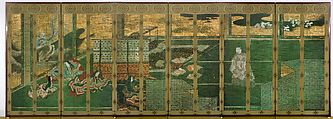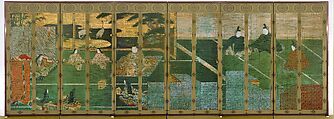Returned to lender The Met accepts temporary loans of art both for short-term exhibitions and for long-term display in its galleries.
“First Song of Spring” (Hatsune) and “Early Spring Greens: Part 1” (Wakana jō)
Tosa Mitsuoki Japanese
Not on view
Horizontal lines painted across the surface of this pair of folding screens and actual textiles applied to each panel imitate the green slats and fabric borders of bamboo blinds. The trompe-l’oeil effect turns the viewer into a voyeur who peers through the blinds into the luxurious rooms of Genji’s Rokujō estate. In the scene from Chapter 23 (right), Genji visits the Akashi Lady’s quarters on New Year’s Day, finding her exquisite possessions and writings elegantly scattered around the room. The scene from Chapter 34 (left) shows Tamakazura introducing Genji to her handsome sons. Paintings within paintings in both screens depict auspicious motifs: chrysanthemums, paired mandarin ducks, and cranes. Together with the narrative content, they convey an ideal image of domestic harmony, filial piety, and good fortune.
Due to rights restrictions, this image cannot be enlarged, viewed at full screen, or downloaded.
This artwork is meant to be viewed from right to left. Scroll left to view more.



